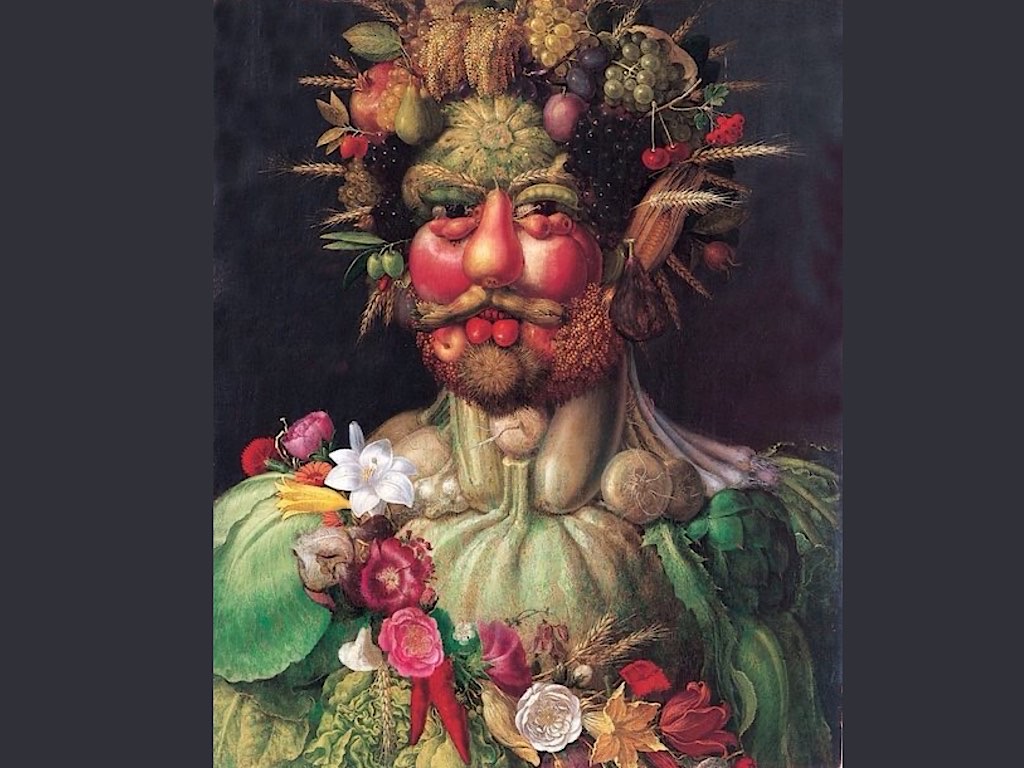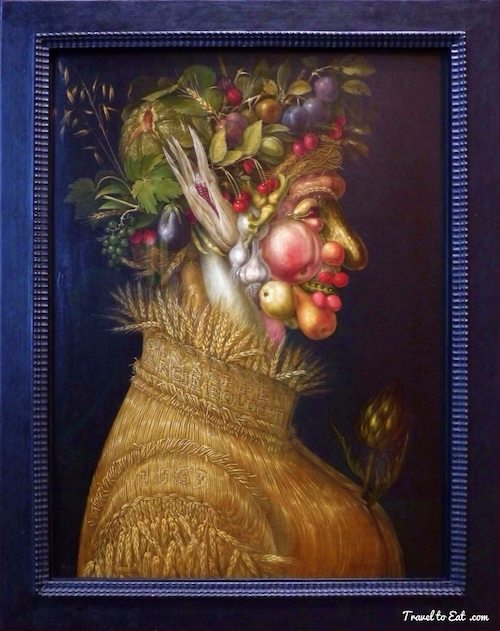
The Kunsthistorisches Museum has a truly amazing collection of paintings and I thought I would highlight some of the artists in separate posts. Giuseppe Arcimboldo (also spelled Arcimboldi; 1527-1593) was an Italian painter best known for creating imaginative portrait heads made entirely of such objects as fruits, vegetables, flowers, fish, and books – that is, he painted representations of these objects on the canvas arranged in such a way that the whole collection of objects formed a recognizable likeness of the portrait subject. Arcimboldo had been a court painter in Vienna for Maximilian II and in Prague for Rudolf II since 1562. In 1563 he began painting his famous collection of the four seasons and the four elements (Earth, Water, Fire and Air), which were presented to Maximilian II on New Year’s Day 1569. While these funky portraits might have gotten most portrait painters executed or at least banished, the Hapsburgs loved them. Arcimboldo was as much a court jester as a painter, the paintings are full of puns, for instance, the ear of Summer is an ear of corn, his nose is a pickle and the date of the painting and signature of Arcimboldo are woven into the straw garment of Summer.
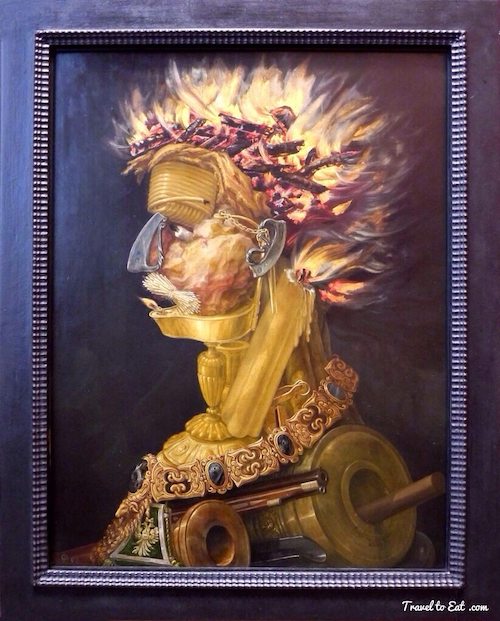
Though his work was forgotten for centuries, Arcimboldo is enjoying a personal renaissance, with shows at major European museums. At the Louvre, a series of Arcimboldo paintings is among the most popular in the collection. The nose and ear of Fire are made of fire strikers, one of the imperial family’s symbols. Also we see the chain of the order of the Golden Fleece and the Two-Headed Eagle alluding to Maximillian II. It was not until the modern era in art that Arcimboldo’s genius was finally understood and respected.
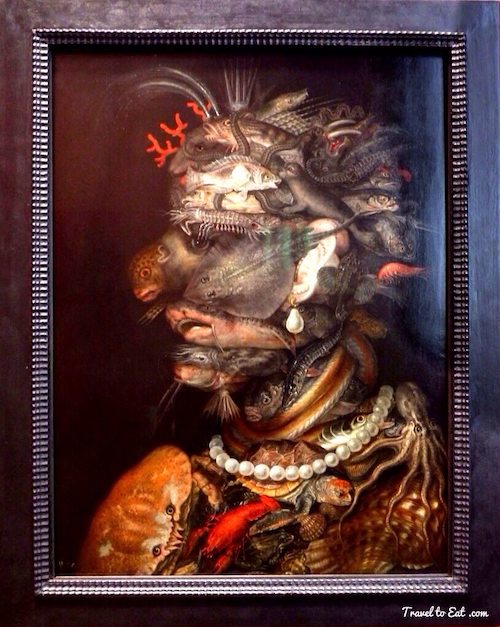
The seasons paintings were created first. In this context, Water corresponds to Winter while Summer relates to Fire, Spring to Air and Autumn to Earth. This was the dawn of disciplines such as botany and zoology, when artists including Leonardo da Vinci, Arcimboldo’s predecessor in Milan, pursued natural studies. Arcimboldo’s composites suggest a scientific fluency that highlighted his patron’s learnedness. “Every plant, every grass, every flower is recognizable from a scientific point of view,” says Lucia Tomasi Tongiorgi, an art historian at the University of Pisa. “That’s not a joke. It’s knowledge.” The paintings were meant to amuse, but they also symbolize “the majesty of the ruler, the copiousness of creation and the power of the ruling family over everything,” says Thomas DaCosta Kaufmann, an art history professor at Princeton who is author of Arcimboldo:Visual Jokes, Natural History, and Still-Life Painting. The Hapsburgs “were very interested in the collection of nature,” Kaufmann says. “They had fishponds. They had pet lions.” The painting Water, shown above, is thought to contain more than 60 species of marine life, among them seals, turtles, sharks, sunfish, crabs, oysters and coral.
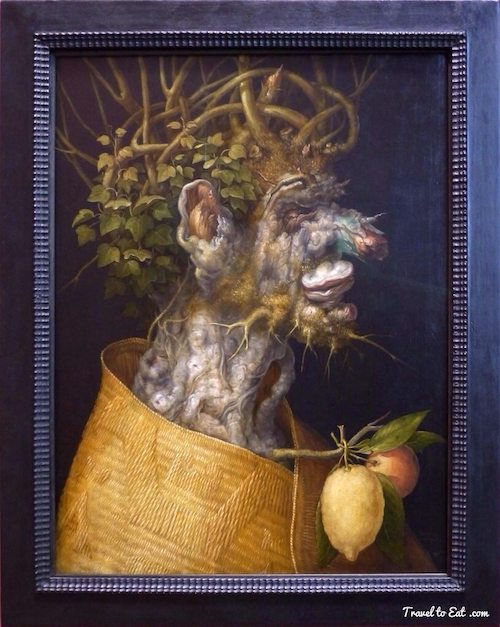
Winter wears a cloak monogrammed with an “M,” presumably for Maximilian, that resembles a garment the emperor actually owned. Maximilian so liked this imagery that he and other members of his court dressed up as the elements and seasons in a 1571 festival orchestrated by Arcimboldo. (The emperor played winter).
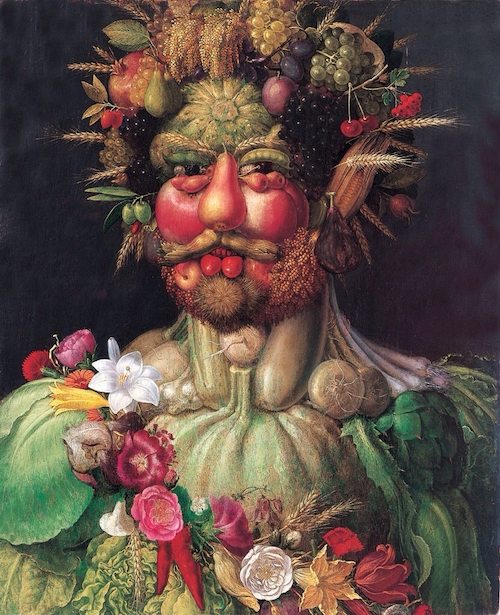
The Kunstkammer in Prague was looted during the Thirty Years’ War (1618-48), and a number of Arcimboldo’s paintings were carried off to Sweden including the one of Rudolf II shown above. The composite heads disappeared into private collections, and Arcimboldo would remain rather obscure until the 20th century, when painters from Salvador Dali to Pablo Picasso are said to have rediscovered him. He has been hailed as the grandfather of Surrealism. Arcimboldo not only cataloged flora and fauna but also related them to the human image. Though his elaborately composed heads were conceived as allegories of a well-tended empire, they remind us of how strained our own relationship to nature has become.
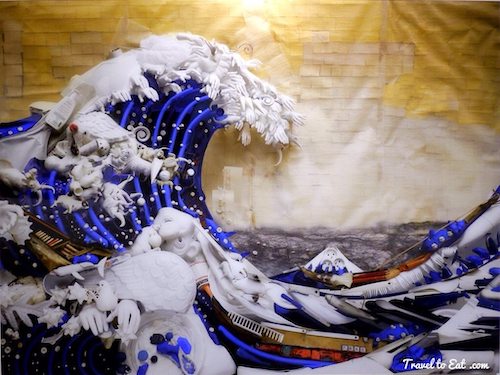
Arcimboldo continues to influence artists today. When we were in Fecamp in Normandy, we attended a show of the artist Bernard Pras. He constructs his spectacular work around illusion through the technique of anamorphosis, an entertaining way of construction through a multitude of objects, which cannot be seen or understood except from the precise vantage point dictated by the artist.
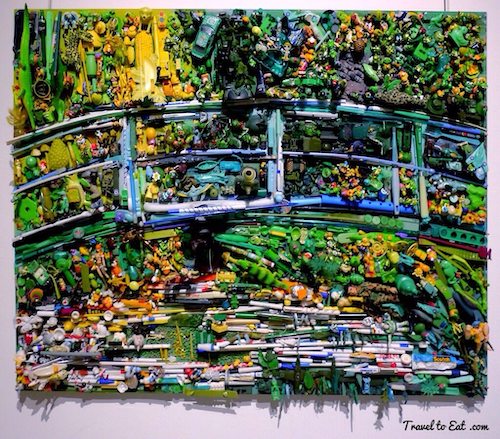
The technique and intent are different from Arcimboldo but you can clearly see the artistic connection. In fact, when you view the work of Bernard Pras from a moderate distance you are certain these are paintings and not collections of “found objects”.
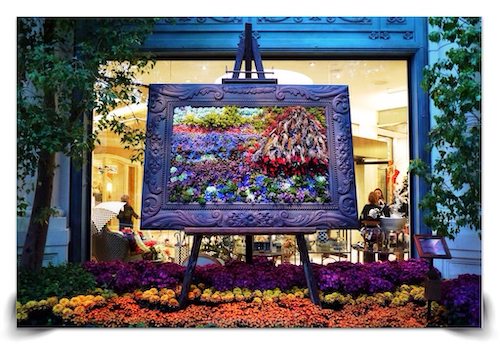
One final example is this collection of living plants meant to portray “Grainstock Sunset” by Claude Monet. If you look carefully, you can make out the haystack in the right of the picture. To me this brings the genius of Arcimboldo full circle. Monet sets out to make a painting of light and plants which are then represented by living plants.
I find the art of Giuseppe Arcimboldo compelling on so many levels, from the humorous puns to the deep seated connection between ourselves and the world around us. If you get a chance to see his work at an exhibition or a museum, I encourage you to experience it for yourself.
References:
Complete works: http://www.giuseppe-arcimboldo.org
Giuseppe Arcimbolo; Genius or Insane: http://www.nytimes.com/2007/10/05/arts/05iht-melik6.1.7766101.html?_r=1&
Smithsonian: http://www.smithsonianmag.com/arts-culture/Arcimboldos-Feast-for-the-Eyes.html?device=ipad
Bernard Pras (flash): http://www.mazelgalerie.com/en/expositions/en-cours/#pageflip
Bernard Pras Facebook: https://www.facebook.com/pages/Bernard-Pras/97345054878

